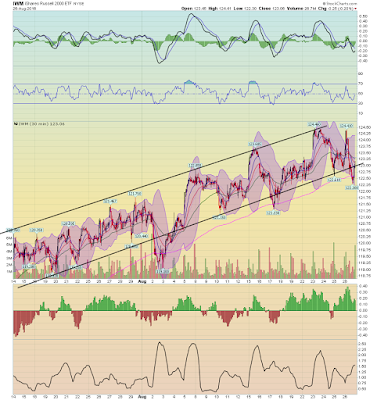Important Charts
Last Week's Sector Performance
The 5-Minute SPY chart has downward bias
The 30-minute QQQ chart is forming a rounding top
The 30-Minute IWM chart briefly broke support last Friday
The daily IEF chart broke support
The price of wheat has crashed to the lowest level in a decade as huge harvests pile up in big growers from Russia to the US, cutting the cost of staple foods around the world.
Extensive planting and benign weather have forced analysts to repeatedly raise crop outlooks. The International Grains Council last week increased its global wheat production forecast to a record 743m tonnes, up 1 per cent from last year.
Mounting supplies have exacerbated a broad washout in commodity markets and heaped pressure on farm economies. At about 220m hectares, wheat fields cover more land than any other grain.
Benchmark soft winter wheat futures on Friday fell 4.4 per cent to $3.83½ a bushel in Chicago, the weakest price since September 2006. Wheat prices are down 71 per cent since 2008, when the most commonly consumed food grain leapt above $13 a bushel and riots swept the streets of some emerging countries.
1-Year Chart of DBA ETF
1-Year Chart of JJG ETF
Central banks have been so good at creating low inflation since the early 1990s that it is now the expected norm by the body politic. Any deviation from low inflation is simply intolerable. In the US, everyone from the media to politicians to the average person start to freak out if inflation heads north of 2%. This mentality seems even worse in Europe. Inflation-targeting central banks, in other words, have worked themselves into an inflation-targeting straitjacket that has removed the few degrees of freedom they had. It is hard to imagine Yellen and Draghi being able to raise inflation temporarily above 2% in this environment. All they can do is operate in the 1-2% inflation window. Inflation targeting's success has become it own worst enemy.
Another way of saying this is that the space for doing macro policy has shrunk to the small window of 1-2% inflation. Not only is monetary policy constrained by this, but so is fiscal policy...
For these reasons inflation targeting has become the poisoned chalice of macroeconomic policy. It was a much needed nominal anchor in the 1990s that helped restore monetary stability. Its limitations, however, have become very clear over the past decade and now is preventing the world from having the recovery it needs...
.....
If a trucker gets stuck in traffic jam, he will have to temporarily speed up afterwards to make up for lost time. On average, his speed for the trip will be the legal speed limit but only if he temporarily speeds up after the traffic jam. Likewise, an economy may need temporarily higher-than-normal inflation after a sharp recession to return to full employment. This also implies temporarily higher-than-normal nominal demand growth. On average, this temporary pickup will keep inflation and nominal demand growth on target. Running a little hot, therefore, is necessary sometimes. Currently, however, this policy flexibility is not possible.






